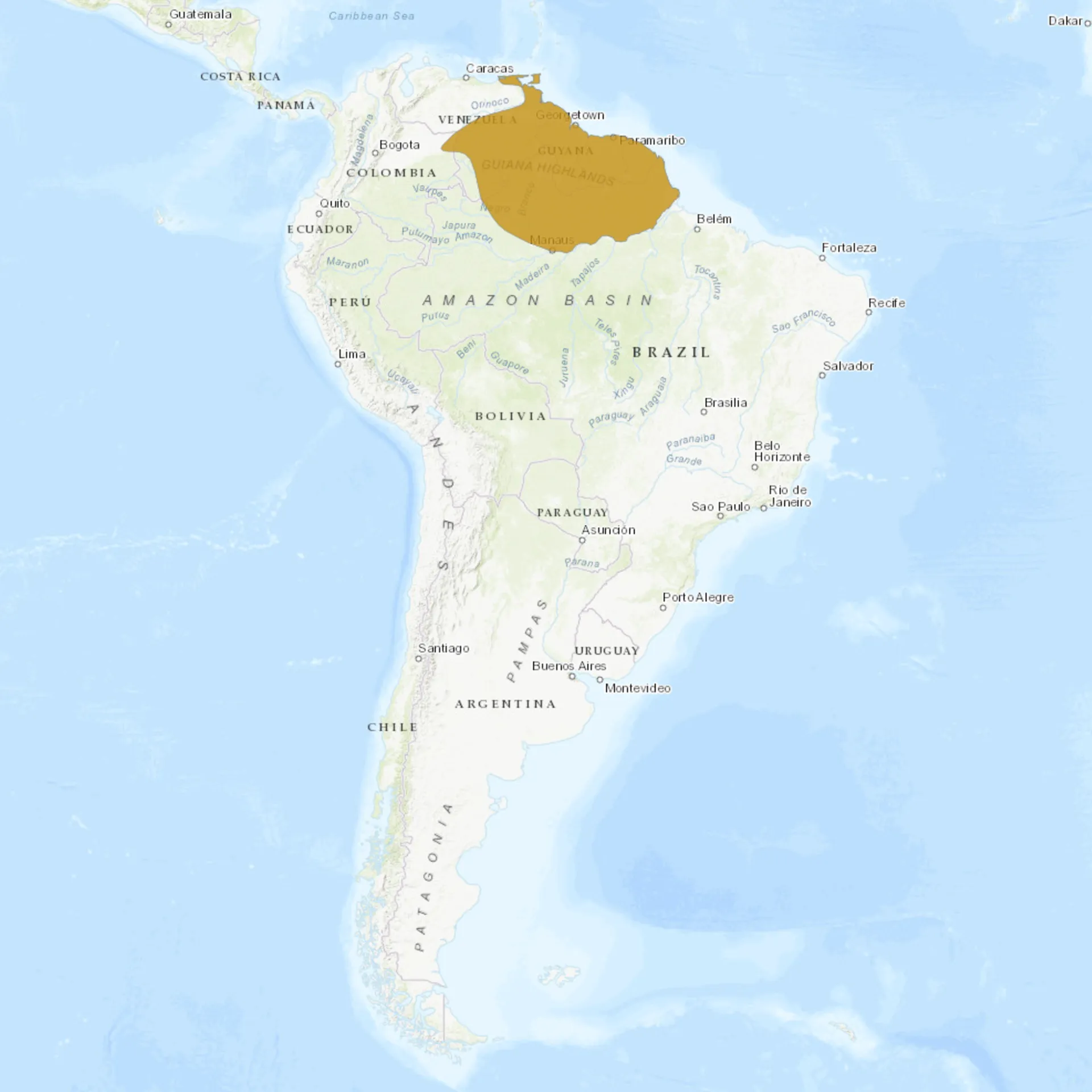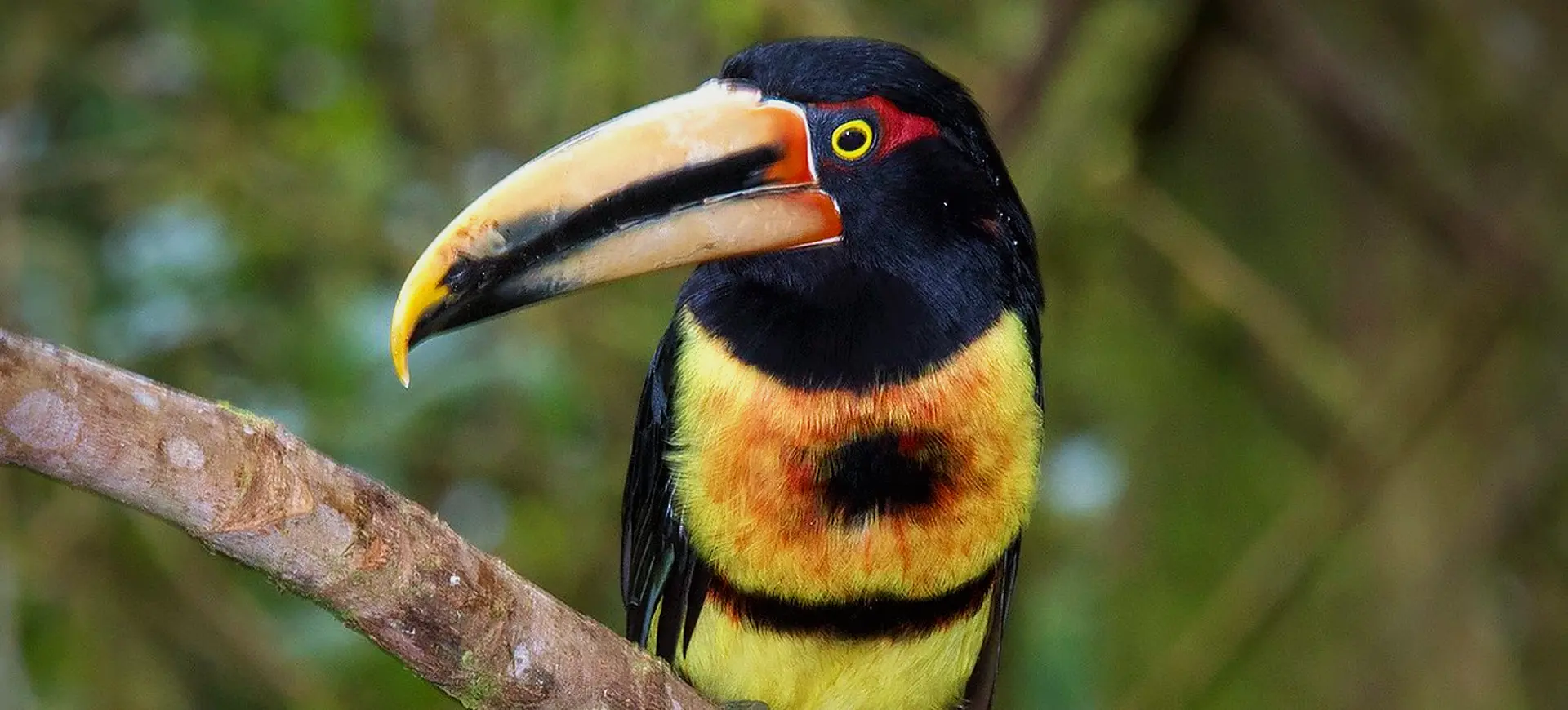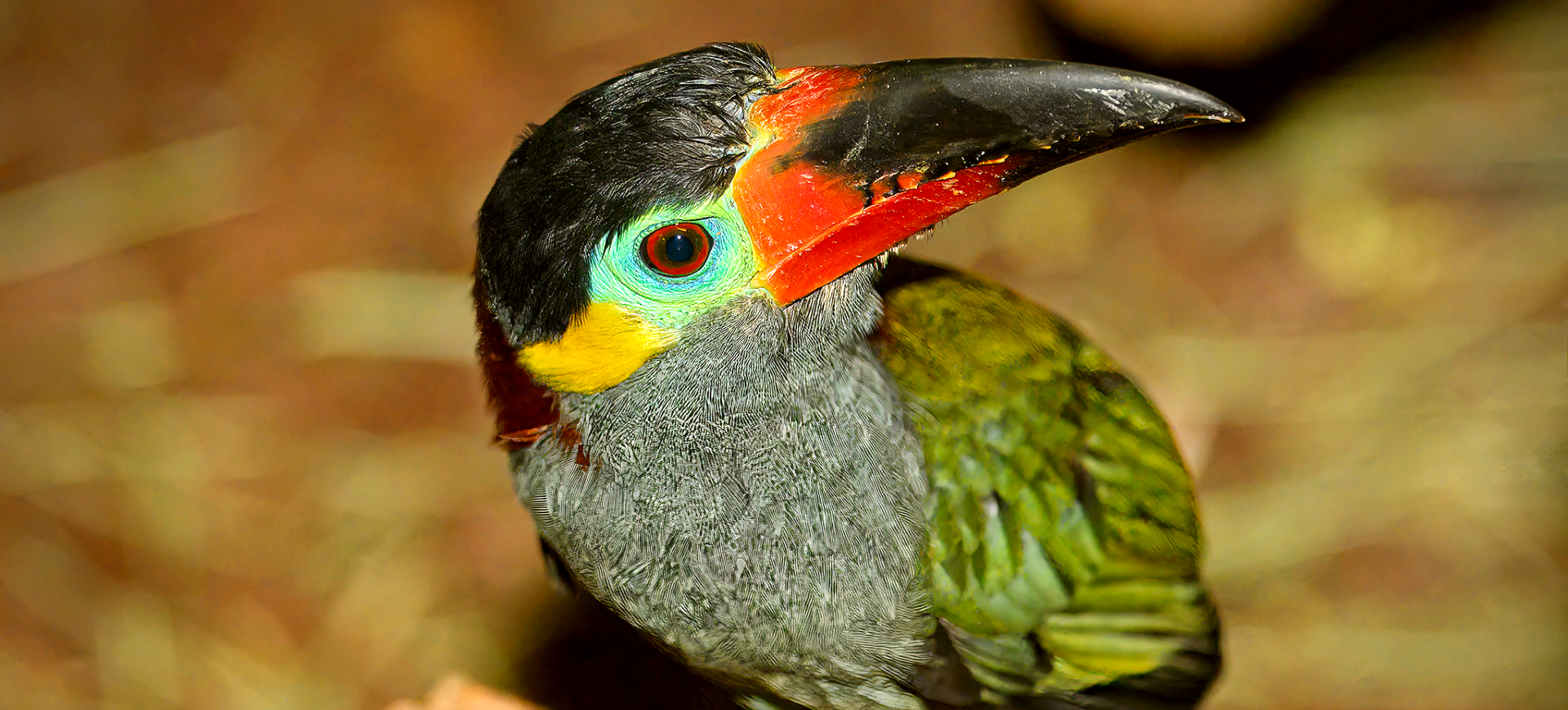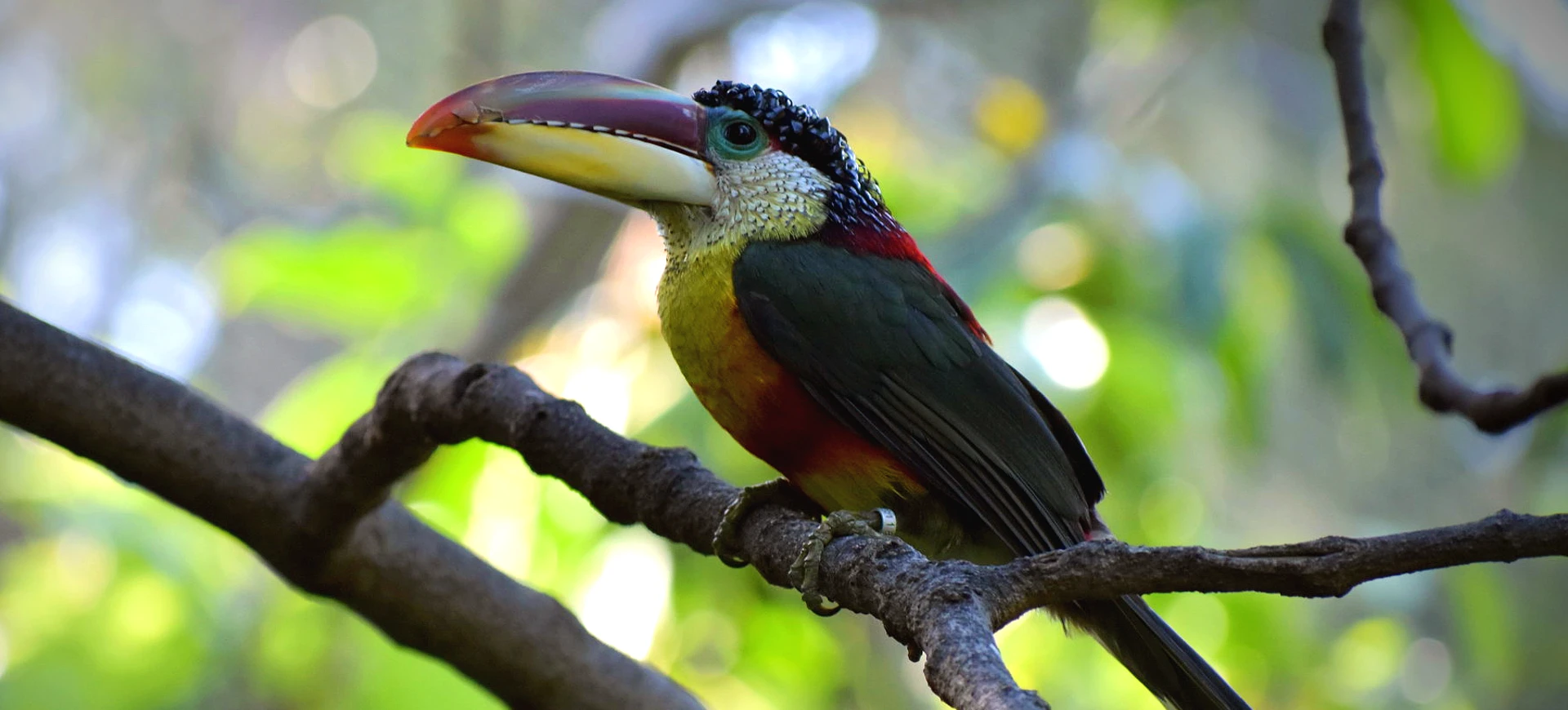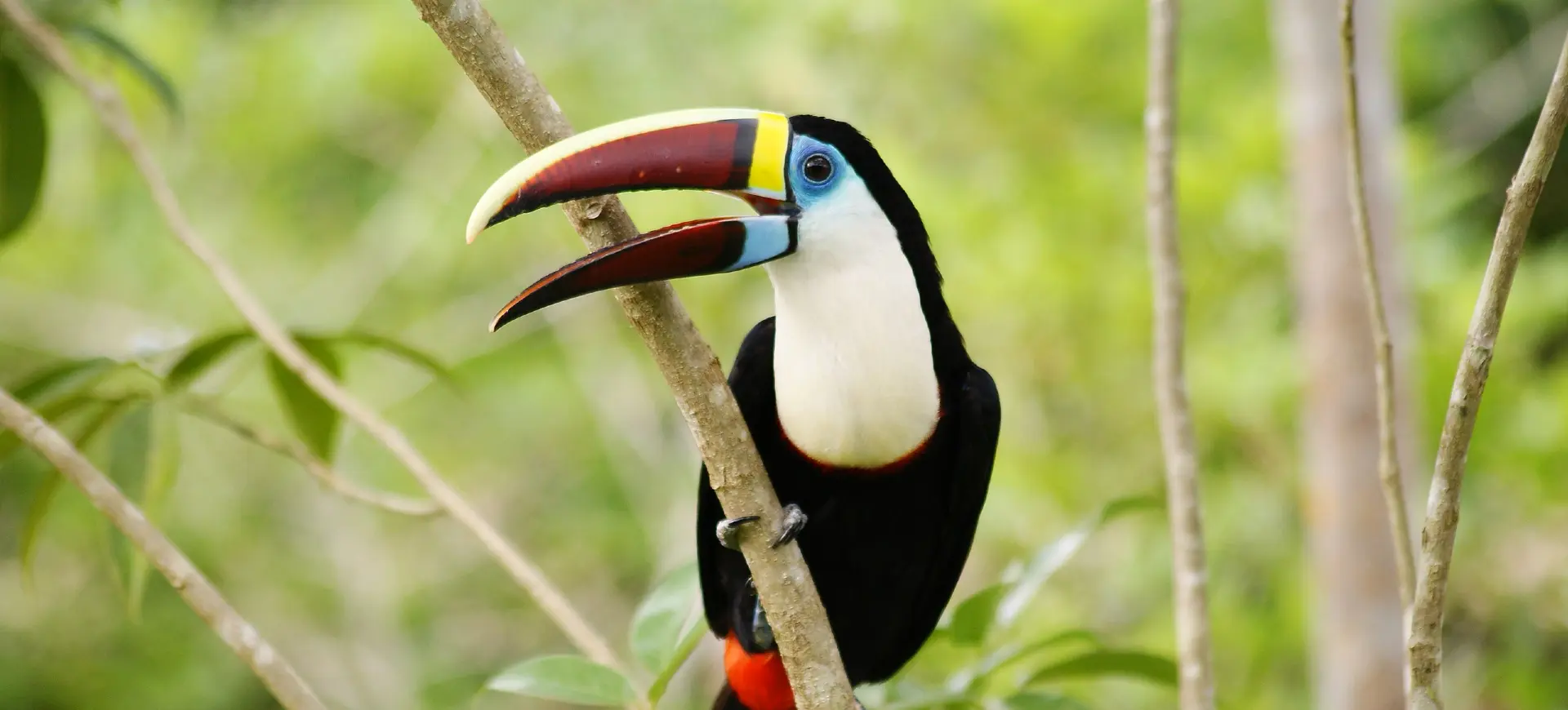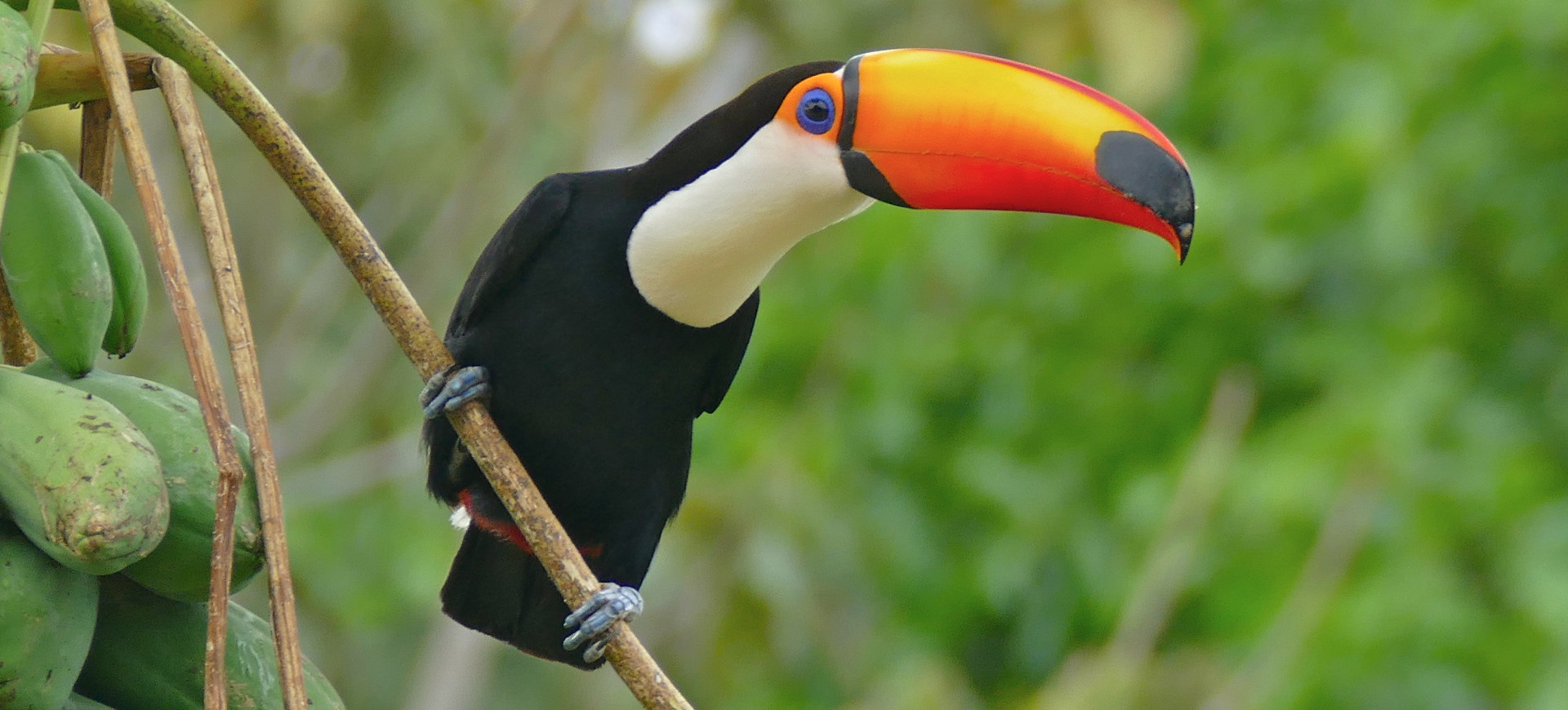Overview
The Channel-billed Toucan (Ramphastos vitellinus) is a strikingly colorful bird known for its large, vividly patterned bill and loud, distinctive calls. It is native to the tropical forests of South America, where it plays a key role in seed dispersal and maintaining the ecological balance of its habitat. This species is highly adaptable, occupying various forest types, including lowland rainforests and secondary-growth areas. Despite its somewhat heavy appearance, it is an agile flyer and moves efficiently through the canopy by hopping from branch to branch.
The Channel-billed Toucan is one of the larger members of the toucan family, characterized by its long, curved bill, which is used for feeding and social interactions. The bill is primarily black with a yellow stripe along the upper mandible, giving the species its distinctive appearance. Depending on the subspecies, it has glossy black plumage, a bright yellow throat, and a blue or red patch around its eyes. This toucan is known for its loud, croaking vocalizations, which serve as territorial calls and communication signals within groups.
This species is primarily frugivorous, consuming a wide variety of fruits, but it also supplements its diet with insects, small vertebrates, and eggs. Its specialized bill allows it to reach and manipulate food efficiently while also serving as a means of thermoregulation. Social by nature, the Channel-billed Toucan often moves in small groups, particularly outside the breeding season. While it remains relatively common across its range, deforestation and illegal pet trade pose increasing threats to its populations.
Taxonomy
Kingdom
Phylum
Class
Order
Family
Genus
Species
Type
Current distribution:
The Channel-billed Toucan is distributed across much of the Amazon Basin, the Atlantic Forest, and parts of the Guiana Shield. It is found in Brazil, Venezuela, Colombia, Ecuador, Peru, Bolivia, Paraguay, French Guiana, Suriname, and Guyana. Though still relatively common in protected areas, habitat destruction leads to population declines in some regions. Fragmentation of forests restricts their ability to move between feeding and nesting sites, increasing their vulnerability.
Some subspecies are more threatened than others, with those in the Atlantic Forest facing the greatest risks due to urban expansion and deforestation. Illegal capture for the pet trade also impacts wild populations, as their striking appearance makes them desirable exotic pets. Conservation efforts focus on habitat protection, reforestation, and reducing poaching. Despite these threats, the species remains adaptable and persists in many areas with sufficient tree cover.
Physical Description:
The Channel-billed Toucan is medium-to-large, measuring around 18 to 22 inches (46 to 56 cm). It has predominantly black plumage with a vibrant yellow throat and chest, contrasting sharply with its dark feathers. The bill is long, slightly curved, and primarily black, with a distinctive yellow stripe along the upper ridge, a key feature differentiating it from other toucans. Around the eyes is a patch of bare, brightly colored skin that varies between blue and red depending on the subspecies.
Its legs are relatively short but strong, allowing it to grip branches securely while hopping through the forest canopy. The feet are zygodactyl, meaning two toes point forward and two points backward, providing excellent grasping ability. The tail is long and rounded, often fanned out slightly when in motion, assisting with balance and communication. Males and females appear similar, though males are typically slightly larger with more pronounced bill features.

Lifespan: Wild: ~15 Years || Captivity: ~25 Years

Weight: Male: 14–24 oz (400–680 g) || Female: 12–22 oz (340–620 g)

Length: Male: 18–22 in (46–56 cm) || Female: 17–21 in (43–53 cm)

Wingspan: Male & Female: 24–28 in (61–71 cm)

Top Speed: Unknown
Characteristic:
Native Habitat:
The Channel-billed Toucan inhabits tropical and subtropical forests across much of northern and central South America. It thrives in various environments, including lowland rainforests, riverine forests, and secondary-growth areas. It is most commonly found in humid forested regions but can persist in partially disturbed habitats where fruit-bearing trees remain abundant. Despite its preference for dense canopy cover, it occasionally ventures into open areas near forest edges in search of food.
This species relies on mature trees for nesting and foraging, using natural cavities for shelter and breeding. It is a canopy-dwelling bird, spending most of its life high in the trees, where it moves by hopping between branches rather than sustained flight. Seasonal fruit availability influences its movements, leading to localized shifts in range depending on food sources. While it is relatively adaptable, large-scale deforestation seriously threatens its long-term survival.
Climate Zones:
Biomes:
Biogeographical Realms:
Continents:
Diet:
Diet & Feeding Habits:
The Channel-billed Toucan primarily feeds on fruit, making it an essential seed disperser in tropical ecosystems. It consumes various fruits from different plant species, often plucking them with the tip of its large bill before tossing them back into its throat. In addition to fruit, it supplements its diet with insects, small lizards, bird eggs, and even nestlings, especially during the breeding season when additional protein is needed. This dietary flexibility allows it to thrive in diverse environments and adapt to seasonal fruit availability.
Toucans’ long, lightweight bill provides an advantage when reaching food on thin branches that might not support their body weight. They play a vital ecological role by dispersing seeds, helping regenerate forests and maintaining biodiversity. In captivity, they require a well-balanced diet of fresh fruit, with supplemental protein sources to mimic their natural feeding habits. Hydration is typically obtained from fruit, but they will also drink water when available.
Mating Behavior:
Mating Description:
Channel-billed Toucans form monogamous pairs that maintain strong bonds throughout the breeding season. Courtship includes mutual feeding, where one mate offers food to the other, reinforcing their bond before nesting. Nesting occurs in tree cavities, usually abandoned woodpecker holes or natural hollows, as toucans cannot excavate their nests. Both parents share responsibilities, with the female laying two to four eggs and both adults taking turns incubating them for about 16–18 days.
Once the chicks hatch, they are initially blind and featherless, relying entirely on parental care. The parents feed the chicks regurgitated fruit and insects, ensuring rapid growth and development. Young toucans fledge after about 40–50 days but may remain with the parents for additional weeks before becoming fully independent. Due to their dependence on large trees for nesting, deforestation poses a significant threat to their reproductive success.
Reproduction Season:
Birth Type:
Pregnancy Duration:
Female Name:
Male Name:
Baby Name:
Social Structure Description:
The Channel-billed Toucan is a highly social bird that lives in small groups or pairs, particularly outside the breeding season. These groups move together through the forest canopy, foraging for fruit and communicating through loud, croaking calls. Within the group, social interactions involve mutual preening and playful bill interactions, which help strengthen bonds among individuals. Despite their social nature, they can be territorial and engage in bill-dueling displays or chase intruders away from feeding or nesting areas.
During the breeding season, pairs become more isolated as they focus on nesting and raising their young. Both parents participate in incubating eggs and feeding the chicks, reinforcing their strong monogamous bond. Flocks tend to be loosely organized, with individuals coming and going based on food availability and seasonal movements. Their cooperative behaviors, such as sharing food sources and warning calls, contribute to their survival in the dense tropical forests where they live.
Groups:
Conservation Status:
Population Trend:
The Channel-billed Toucan remains relatively widespread across its range, but its population is decreasing due to habitat loss and fragmentation. It is still commonly found in well-preserved forests, especially in the Amazon Basin and protected areas of South America. However, subspecies in the Atlantic Forest are experiencing more significant declines due to extensive deforestation, making their populations more vulnerable. While exact population numbers are unknown, ongoing environmental pressures suggest a gradual decline in some regions.
The species remains stable in suitable habitats and can adapt to secondary forests if sufficient fruit-bearing trees are available. However, forest fragmentation limits their ability to move between food sources and nesting sites, increasing competition and predation risks. Illegal pet trade further reduces wild populations, as these birds are often captured and sold in the exotic pet market. Conservation efforts, including habitat protection and reforestation, are crucial to ensuring the long-term survival of this species in the wild.
Population Threats:
The primary threat to the Channel-billed Toucan is habitat destruction due to deforestation for agriculture, logging, and urban expansion. Large-scale clearing of tropical forests, especially in the Amazon and Atlantic Forest, reduces the availability of nesting sites and food sources, leading to population declines. Fragmentation of their habitat also isolates populations, making it more difficult for individuals to find mates and sustain genetic diversity. Forest degradation limits fruit availability in some areas, forcing toucans to venture into human-dominated landscapes where they are more vulnerable to predation and other threats.
Illegal capture for the pet trade is another significant threat, as the Channel-billed Toucan’s striking appearance makes it a highly sought-after exotic bird. Poaching disrupts wild populations by removing breeding individuals, further contributing to their decline. Additionally, climate change poses a long-term threat by altering fruiting patterns and reducing food availability in certain regions. While the species is still classified as Least Concern, continued deforestation and illegal wildlife trade could accelerate population declines if conservation measures are not enforced.
Conservation Efforts:
Several conservation initiatives aim to protect the Channel-billed Toucan through habitat preservation and reforestation projects. Protected areas such as national parks and wildlife reserves in the Amazon and Atlantic Forest regions help maintain stable populations by safeguarding critical nesting and foraging sites. Conservation organizations work to promote sustainable land-use practices, reducing deforestation caused by agriculture and logging. Efforts to restore degraded forests by planting native fruit-bearing trees also help ensure a stable food supply for toucans.
Anti-poaching measures and enforcement of wildlife trade regulations are crucial in preventing illegal capture for the pet trade. Some conservation programs focus on educating local communities about the ecological importance of toucans, encouraging support for habitat conservation and discouraging poaching. In captivity, breeding programs in zoos and aviaries maintain genetic diversity and raise awareness about the species’ conservation status. Continued monitoring of wild populations and habitat loss trends is essential for assessing long-term conservation needs and implementing effective strategies.
Additional Resources:
Fun Facts
- The Channel-billed Toucan is renowned for its large, colorful bill, which can grow up to 5.1 inches (13 cm) long, making it one of the most distinctive bird features.
- Despite its size, the bill is surprisingly light due to its internal structure, composed of bone struts filled with spongy tissue.
- These toucans are highly social birds, often seen in small flocks of about 6 to 12 individuals, communicating with each other through loud, croaking calls.
- They play an important ecological role as seed dispersers in their habitat, aiding in the regeneration of forest areas.
- The diet of Channel-billed Toucans primarily consists of fruit, but they also eat insects, small birds, eggs, and nestlings.
- Their vibrant bill is not just for show; it’s used for foraging, reaching fruit at the tips of branches too weak to support their weight, and courtship rituals.
- Channel-billed Toucans are capable of rapid color changes in the skin around their eyes, which can shift from blue to red, especially during mating season.
- They are native to the neotropical forests of South America, ranging from eastern and northern South America to Trinidad.
- Channel-billed Toucans nest in tree cavities and often use holes created by other animals like woodpeckers.
- Although they are powerful flyers, these toucans are often seen hopping around tree branches.


